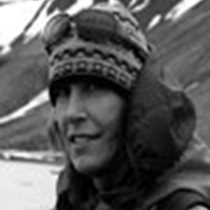Svalbard: Kapp Fanshawe, Kapp Freeden and Nordauslandet Ice Cap
Plenty, bounty, wealth, pulchritude. I could go on, but you get the picture. In the spare, harsh Arctic, we found example after example of abundance today. It began early, before breakfast, with whales. On our approach to Kapp Fanshawe, we found five or so humpbacks and a few fin whales. As if that weren’t glorious enough, one young humpback began tail lobbing and tail breaching. Coffee in hand, cameras at the ready, we watched.
As the morning (still pre-breakfast, I might add) progressed, we neared land. And what a dramatic headland it was! Our ship geologist, Scott, said that in the Geology 101 textbook he uses, the headlands of Kapp Fanshawe are used as a premier example of the Great Dolerite Sill formation. The cliffs had more to offer than “just” tumbling glaciers and dramatic geology, though. They were the starting point of a superhighway of avian activity. Birds winging overhead and paddling in the water around the National Geographic Explorer were commuting from their nesting colonies on the cliffs.
At the cliffs, hundreds upon hundreds of Brünnich’s guillemots were lined up along the narrow ledges, their black backs with two tiny white dots turned toward us, for all the world looking like a smart tuxedo coat with bright buttons. Guillemots flapped on the ledges. Guillemots flapped above us. Guillemots dove and surfaced with arctic cod in their beaks. We could even hear some of these mostly-silent birds letting loose their hoarse cries. We didn’t see many chicks in the water or on the cliffs, but some of their cries were heard. Brünnich’s guillemots have a unique chick-rearing system. Before the chicks can even fly, they tumble down the cliffs to their fathers, who are calling to them from the water. Then, they spend about a month swimming and diving with their devoted dads before they are on their own. We joked that the lucky chicks were the ones whose parents had laid their eggs on the lower ledges. Those nesting near the clifftops had hundreds of yards to fall—a treacherous beginning to a life.
The chaos was heightened by hordes of black-legged kittiwakes, which were also nesting on the cliffs. Their smart nests were almost overwhelmed by the huge young still perched in some of them. Soon, the fledging will be complete, and the nests left for the long winter season as the birds move away.
The big drama, though, was the surprising appearance of an Arctic fox dashing along the loose scree at the cliff base. A fox! And all white! This animal must have either changed to its winter pelage early or possibly never changed at all. It shone against the bird-fertilized greenery, and at one point it made a mad dash straight downhill, chasing something—kittiwake chick? glaucous gull chick?—we couldn’t tell what it was, but it seemed to be delicious, for the fox hunched and devoured it quickly.
Breakfast gave us time to recharge a bit, then we headed ashore for a tundra walk at Kapp Freeden. The ground here, like our walk the other day, appeared bare from the ship, but once our boots were on the ground we could see the tenacious beauty of the tundra. Sulphur-colored buttercups, purple mountain saxifrage and Svalbard poppies were still in bloom. Tiny, but bright. On the slope, we could see how ice wedges create a slightly different topography and moisture, becoming green lines of moss across the landscape. Three reindeer seen from the ship had dashed off as we approached shore, but many hikers saw them grazing at the edge of a pool, their bodies low and squat, the antlers of the male incredibly impressive. It was difficult to leave such a beautiful spot, but the afternoon was approaching, and we had more to see.
Our plan was to head to the Nordauslandet Ice Cap, but we got side tracked at Wilhelmøya Island by 12 – 15 feeding humpback whales. We could track their efforts by the flocks of black-legged kittiwakes that swarmed above the water just before the whales surfaced through their bubble nets. It is unusual to see bubble-netting in this part of the world, although it’s quite common in many other areas. It also surprised many of the naturalists aboard, who had been coming here for years, to see so many humpbacks. What caused the change? Perhaps it is the recovering population recolonizing some former haunts. Perhaps the drop in ice cover has allowed an expansion of range. Perhaps we were just lucky. Either way, we stood on the bow and watched them feed (even catching a few dramatic views of pink ventral pleats from one lunger) while Dennis, our undersea specialist, took a Zodiac out with the remote operated vehicle to see if he could capture what they were hunting on film.
Austfonna, the ice cap, still awaited. Here, rather than a bounty of wildlife, we found a bounty of ice. One hundred miles or more of “coastline” marks the edge of this huge ice cap. Numbers don’t do it justice. The best way to appreciate such a thing on a day as beautiful as this (a few clouds shielded and gave texture to the sky) is to gawk. We gathered on every deck and did just that. Chutes of water were streaming from the ice cap as if from gargoyles. Caves marked some of the face, but for the most part it was a jaggedly undulating sheer wall of ice. From the uppermost deck, we could just peer onto the top of the cap. A few black-legged kittiwakes perched here and there, but, for the most part, it was ice and ice alone. And that, to be honest, was better than enough. It was marvelous.




